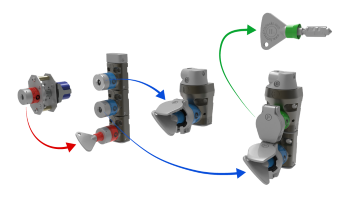Providing Controlled Access to Areas Containing Hazards
The concept of trapped key systems is still widely used to provide personnel protection in industrial environments despite being around for more than a century. Depending on the application there may be slightly different requirements, but in general, trapped key systems enforce a sequence of operations in a predetermined order through the transfer of keys that are either trapped or released.
How Do Trapped Key Systems Work?
Trapped key systems can be used in a number of ways:
✅ to control hazardous energy from one or more energy sources using an isolation control device;
✅ to enforce a predetermined sequence of events using a key exchange device;
✅ to control access using an access lock; and/or
✅ to implement a proactive inhibit function using a personnel key

To control hazardous energy from one or more energy sources (e.g., electrical, pneumatic, hydraulic), a trapped key energy control device would be selected for each hazardous energy source. The energy is isolated by rotating the key, which is then released. The key can then be held by the person doing the task as a personnel key, placed in a key exchange device, or placed in an access lock per the requirements of the application. While the key is removed, the energy source is prevented from being accidentally turned on.
To enforce a predetermined sequence of events, a key exchange device is selected. Such device accepts one or more keys from the previous step in the sequence and releases a key (or multiple keys) for the next step. In more complex applications, such as those with multiple sources of hazardous energy, each key associated with an energy source must be inserted into the key exchange device before any keys are released.

To control access, an access lock is installed on a movable guard. An access lock requires a key to be inserted, either from an energy control device or from a key exchange device. Once the key is inserted, the actuator is released, allowing the guard (or other access point) to open. The key is trapped and cannot be removed until the guard is closed and the actuator is re-inserted into the access lock.
At the access point, an additional level of protection can be added by using a proactive inhibit function such as a personnel key. The personnel key remains trapped until the access key from the previous step in the sequence is inserted into the access lock. This releases the personnel key before then releasing the actuator, allowing the operator to take the key with them into the safeguarded space. Until the personnel key is returned, the access key remains trapped and the access lock cannot be reset.

Whether using an isolation control device, a key exchange device, an access lock, or a combination of one or more of these, the defined process requires exact reversal to re-energize the hazardous energy or to restart the machine.
Where are Trapped Key Systems Used?
Historically, the concept of trapped key originated in the rail sector. Nowadays it is used in various industries such as food and beverage (F&B), third-party logistics, and manufacturing to protect personnel and equipment, enforce processes, and improve productivity.
The versatility of trapped key systems makes them appealing across several sectors, including non-industrial settings such as zoos.
How Fortress can Help
Fortress specialises in interlocking and has expertise in designing and providing trapped key systems to meet the requirements of each application. In particular, Fortress has a range of mechanical trapped key interlocks, mGard.
Made of metal alloy (but also available in stainless steel), mGard can operate in the most demanding environments, is suitable for various industries ranging from metal manufacturing to F&B, and can be incorporated into almost any new or existing setting.
Suggested Related Pages





